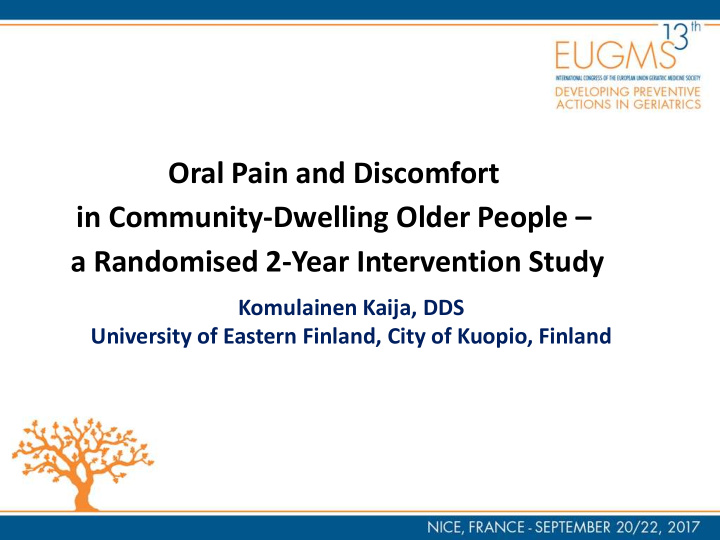



Oral Pain and Discomfort in Community-Dwelling Older People – a Randomised 2-Year Intervention Study Komulainen Kaija, DDS University of Eastern Finland, City of Kuopio, Finland
SMART SCIENCE BY SMART PEOPLE UNIVERSITY OF EASTERN FINLAND JOENSUU | KUOPIO | SAVONLINNA I have no potential conflict of interest to report
Introduction • Oral pain and discomfort may cause problems in eating, speaking and swallowing. • The infection-free mouth with no pain or discomfort supports good everyday-life of the old people .
Oral Health Intervention Study • The study was a part of the larger GeMS-study (Geriatric Multidisciplinary Strategy for the Good Care for the Older people) • The parent GeMS-study: • A multi-component, longitudinal intervention study conducted in the City of Kuopio, Finland, 2004 – 2007 • The aims were: • to optimize medical treatment, medication and to improve and prevent decline in function and nutrition in community-dwelling old people
Aim of the current study • To study, whether oral health promoting interventions improve oral self-care and oral health among community dwelling older people ≥ 75 years.
Oral health intervention • Oral health intervention included: • individually tailored instructions for oral and/or denture hygiene • relief of dry mouth symptoms • use of fluoride, xylitol, or antimicrobial products • professional cleaning • The dental treatment was also given if needed • In the control group, participants used dental care services after their own consideration
Study design • Parent GeMS-study: • Random sample of 1000 persons aged ≥ 75 years in the year 2003 (born before November the 1st 1927 ) and living in Kuopio • Intervention group n=500 • Control group n=500 • This Oral Health Intervention Study: • The study group was the intervention group of the parent GeMS-study, divided into intervention and control groups.
Study population • At baseline an interview and a clinical oral examination to community-dwelling participants: • N Total = 354/500 • N= 186 in the intervention group • N= 168 in the control group • At the end of the study • N Total = 279 /500 (55.8%) participants completed the 2-year study • N= 145 in the intervention group (N= 68, 46.9% dentate) • N= 134 in the control group ( N= 80, 59.7% dentate)
Baseline characteristics of the participants • Mean age 81.6 years • Women 75.8 % • MMSE, high score 25-30, 78.2 % • IADL, high score 8, 46.7 % • Dentate 52.3 %, of which 20 teeth or more, 35.7 % • Gingivitis 58.1 % • Presence of deepened periodontal pockets 58.8 % • Good oral hygiene (dentate) 33.3 % • Removable dentures 76.9 % • Denture stomatitis 20.2 % • No unstimulated saliva flow 27 %
Self-reported oral pain and discomfort Intervention group Control group n=145 N= 134 Baseline 31 % (n=45) 22 % (n=30) After 21 % (n=30) 18 % (n=24) 2 years Changes were not statistically significant
Self-reported main reasons for pain and discomfort Intervention group, Control group, problems with problems with • removable dentures, n=16 • removable dentures, n=7 Baseline • teeth/gingiva, n=13 • teeth/gingiva, n=11 • mucosa/tongue, n=13 • mucosa/tongue, n=6 • teeth/gingiva, n= 11 • teeth/gingiva n=13 After 2 years • removable dentures, n=9 • removable dentures, n= 7 • mucosa, n=5
Conclusions • The interventions slightly decreased oral pain and discomfort but the changes were not statistically significant. • Oral problems were common; in every fifth of the participants, despite intensive prevention, oral hygiene counselling and dental treatment. • It is a big challenge to keep healthy and painless the mouth with heavily restored teeth, gingiva problems, worn-out dentures, thin mucosa and decreased saliva flow rate.
Considerations • In general, the oral pain and discomfort are likely widely underreported for many reasons, typical to the older people: • pain is a natural part of aging – also in the mouth (e.g. dry mouth) • due to adaptation to the discomfort situation (worn-out dentures on reduced alveolar bases) • it may be a challenge to go and get dental treatment • the treatment causes costs
Thank you for your attention! • Kaija Komulainen, DDS (kaija.komulainen@dnainternet.net) • Sirpa Hartikainen, MD, Prof . • Irma Nykänen, PhD, Nutritionist • Annamari Nihtilä, DDS
Recommend
More recommend